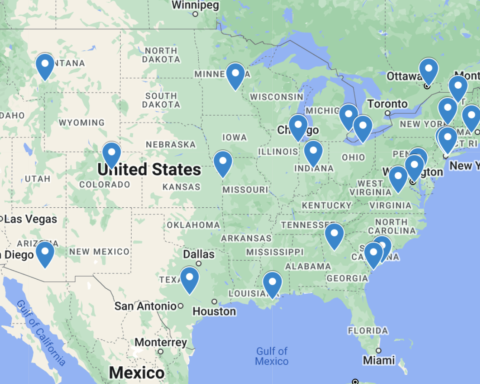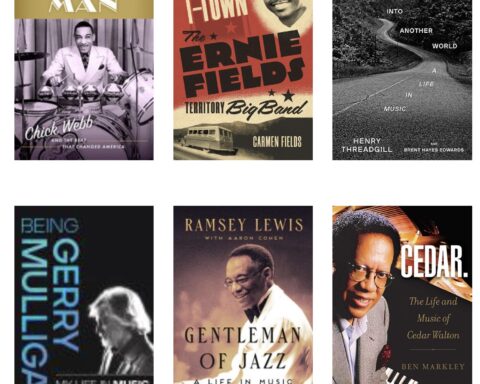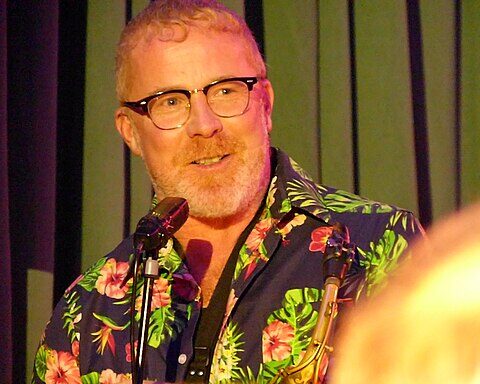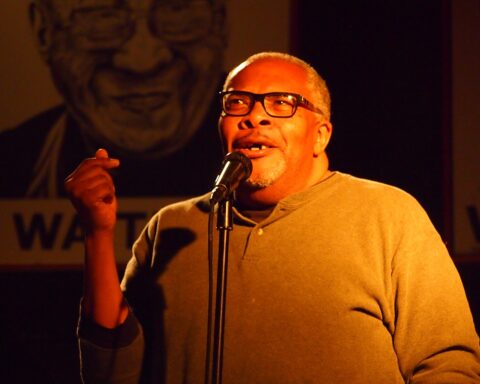New York, January 10, 2011 — JJA President Howard Mandel grabbed the blue-padded chairs in Conference Room C at Manhattan’s midtown Sheraton Hotel and started rearranging them into two concentric circles, urging others to do the same. Mandel wanted the JJA’s January 8 town hall meeting, “The State of Jazz Journalism Now,” to be more of a democratic discussion than a typical conference panel.
To that end, the moderator, Ottawa writer James Hale, and the advertised panelists — bandleader Darcy James Argue, New York Press/City Arts editor Jerry Portwood, Manhattan writer and JJA News editor David R. Adler and Moja Radio DJ Russ Davis — were scattered throughout the circles. The format worked: The back-and-forth discussion was as egalitarian as it was lively.
The discussion quickly drifted from the state of journalism to the state of jazz itself, which is not quite the same thing. Jazz musicians, promoters and record companies are trying to sell recordings and concert tickets, while jazz journalists are trying to sell articles. The musicians are trying to create great music, while the journalists are trying to create great prose. The two activities are related, of course. But contrary to what many musicians, promoters and record companies think, it’s not the journalist’s job to sell albums and tickets; it’s the journalist’s job to describe, contextualize and illuminate the music.
The usual litany of laments — imploding CD sales, shrinking or disappearing publications, disappearing venues, rising travel costs — were ticked off. The Internet was offered as both the problem and the solution. It’s a problem in that it has undermined CD sales and print publications without coming anywhere close to replacing their income stream. But, as Russ Davis pointed out, “The Internet is now the portal that everything flows through,” and any solutions will have to flow through the same aperture.
Blogger Giovanni Russonello of capitalbop.com advocated finding specialized niches on the Internet — either local scenes or musical movements — as a way to build an audience. There have always been local newsletters and niche magazines, and it makes sense that they would migrate to the web, but others pointed out that jazz also needs aggregators that bring a digest of these niche concerns to a broader jazz audience. Adler suggested that jazz needs to be better connected to the broader culture to create more crossover stars like Esperanza Spalding. Several people suggested the international market as a way to get out of the American box.
Every proposed solution, though, tripped over the same tree root: money. Yes, one can write a blog on the Internet or post free music or host a web radio show, but how does one get paid? A smallish but devoted audience exists for both jazz and jazz journalism, but the structure for getting that audience to pay for music and criticism is broken. As Argue pointed out, he can post live recordings on his website to get more people to come to the shows, but that model doesn’t pay for the costs of a studio recording. “A lot of people liked our last studio recording,” he said, “and they ask when’s the next album coming out? And I say, ‘When the first one’s paid off.’”
Attending the Town Hall were writers and editors from JazzTimes, Down Beat, Jazziz, The Washington Post, The Philadelphia Inquirer, The Village Voice, The Nation, Washington City Paper, New York Press, City Arts, Signal to Noise, Wire and AllAboutJazz.com, as well as representatives from National Public Radio, WBGO 88.3FM (New Jersey), Pi Recordings, HighNote Records, the DC Jazz Fest and the Detroit Jazz Fest.





thanks, Geoffrey. wish i could have been there. as with the JEN Conference, i'm curious to learn about anything new that might have come out of these discussions. for example, other than using social media to cross-promote one's work, were there any proposals offered for new options or opportunities for journalists? and i know everyone is spread thin with dwindling resources, but is it possible to have live streaming for such meetings in the future, so that more people might participate in real time?
Live streaming was not available at the Sheraton New York Hotel during the JJA's conference for a variety of mostly budgetary reasons, but it is our intent to use live streaming as often as we can afford to in discussions to come. The forum Geoffrey reported on was poorly documented with a pocket video camera; I'm trying to edit valuable exchanges into eyeJAZZ clips currently. Yes, there were proposals of new options and opportunities for journalists, mostly revolving around research into local niche online publications' (including Patch) needs of arts journalism and entrepreneurial efforts by jazz journalists to present information prior to local engagements, in conjunction with presenters themselves. There are ideas about jazz journalist bloggers uniting to offer their sites as a combine to potential ad buyers. The suggestion that resonated most was that jazz journalists must develop new skills regarding new media, if they are to have any hope of paying work in the new journalistic landscape at all. There's no promise they'll get work, but certainty that if they don't have skills regarding new media, they won't.
Just to clarify my remark: I'm not sure how many more crossover stars like Spalding can emerge, or whether that's something anyone can even control. But I do think the Spalding phenom points to a creeping change in the status of jazz musicians in U.S. pop culture.
During the forum, my friends Jim Macnie and Ted Panken opined that this was a blip, a fluke, not so significant. I disagree, and would point as well to the appearance of Christian Scott on Jimmy Kimmel's show, or the appearance of Kurt Rosenwinkel on Jimmy Fallon's show, etc. There's no reason to think this sort of thing won't keep happening. And I think it creates an opening big enough for jazz journalists to drive a truck through.
Thank you for this great piece...and so what were the potential solutions floated for bringing a positive cash flow to all involved, including the artists, as well as the journalists and producers?
And as far as emerging artists crossing over, the younger adult public is quite open- think 10,000+ songs on an i-pod of multiple genres...question is, is the older adult public as open? Or better yet, how do we open up the minds of jazz fans who are stuck in jazz that can only harken back to the last century?
Personally, and I'm no spring chicken myself, I'd love to see and hear concert bills that were a true mixture of jazz genre, akin to the 60's/70's Bill Graham Presents (speaking of harkening back to the last century!) shows where a Miles Davis could be on the same bill with a rock act. If we're going to expand the jazz party, and thus, the potential revenue stream, we have to make invite everyone to the party, not just those who already know what they can or can't like...
Thanks for the opportunity to comment.
Lynn Ray
Pardo and Ray Music
San Francisco, Ca